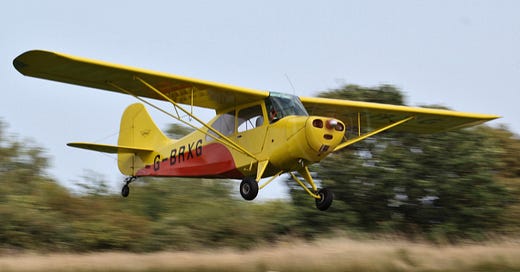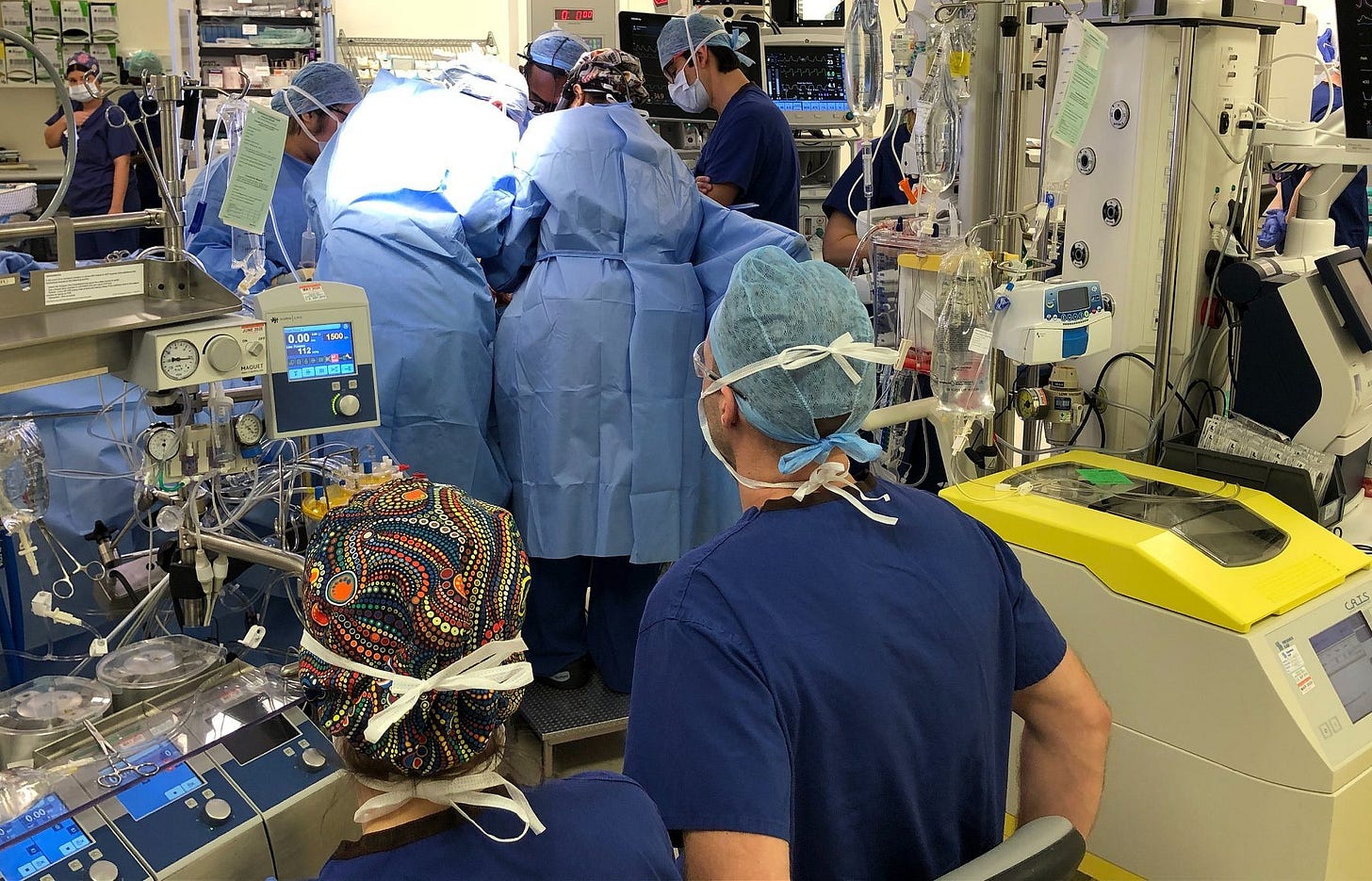Four years ago today my heart had stopped and I was not breathing. A machine took the blood from my body and oxygenated it before pumping it back in to keep my brain and other organs alive. My lungs were collapsed as they sawed through my breastbone to expose the chest cavity.
This was an operation at Papworth Hospital in Cambridgeshire to replace my aortic heart valve with a new one made from bovine pericardium preserved with glutaraldehyde. If it had gone badly, my last memory would have been of watching fluffy falling snow through a window onto a dark morning but the team were incredible and it went well. I saw the next years’ snowdrops and plan to see many more springs come around.
I’d been born with the wrong type of valve, apparently. By now I was pushing blood though a hole less than a millimetre across where it should have been about 3 centimetres. If it hadn't been found and fixed it is likely that my lifespan would have been measured in weeks. So, they made me a new one from a cow – not a whole cow, obviously, just part of one.
It’s really mindbogglingly amazing that they can do that and, four years later, I can write about it. Medical science is full of wonders and this is truly one of the most wondrous, at least from my personal point of view.
There are several choices when it comes to getting a new heart valve. The first, of course, is to refuse the offer but as it was clear that if I did this I wouldn’t be around long enough to finish even a moderately small jigsaw, I decided against this option. So, having decided to go along with the doctors’ plans, I had to choose a type. It was recommended, as I was fairly young, that I should have a mechanical valve made of carbon and titanium as that would probably outlast me. Unfortunately, this also involved taking drugs for the rest of my life and I didn’t feel that I wanted that.
So, I chose a bioprosthetic valve. They can give you a new valve from a pig or manufacture a valve from the sac that surrounds a cow’s heart. If you have the pig valve it is literally that, a valve from a pig’s heart. We are so similar that it’s more or less a straight swap. Mind you, if you’ve ever looked into a pig’s eyes, you’ll know that there’s not a lot separating us. I don’t mean lovingly gaze into their eyes, by the way, it’s my heart that’s broken, not my brain - at least not in a way that the medical profession have diagnosed.
If you have a valve made from cow, then the process is far more complicated but I had read that: “Prior to implant, cow valve replacements undergo rigorous quality testing to ensure the valve is durable enough to be used in surgery”, so that was re-assuring, eh? Like they wouldn’t bother, like they’d just knock one up in their lunch break and say: “That’ll probably do.”
The major drawback, I was told, was that I could only plan on it lasting ten years but that doesn’t mean I can’t hope it will last twenty. I now have a 25 mm Carpentier-Edwards PERIMOUNT Magna Ease Bovine Aortic Heart Valve. I’m not sure if they're chasing TrustPilot reviews but it would be five stars from me. Mainly on the grounds that I’m not dead.
So, here I am, forty percent of the way through the warranty on that valve and determined to live every single day to the very best of my ability. I have had a great passion in my life for forty years now and today is a very special day because I have fallen in love with a grand old lady.
The Aeronautical Company of America was founded in 1928 and changed its name to Aeronca Aircraft Corporation in 1941. It was at around this time that the United States Army Air Corps ordered the first four Aeronca 65 TC Defenders for evaluation. Almost 1500 would be delivered to the armed forces of the United States over the next few years.
Immediately after the end of the Second World War, the company started selling the Aeronca 7AC Champion to the post-war American aviator. At its peak, the factory was building up to fifty Champs every single working day. In 1946, N85178 was the 3910th Aeronca 7AC Champion to roll off the production line at Hook Field Municipal Airport in Middletown, Ohio. One of its early owners was Hjalmar Sonni Koski who lived at 527 Second Avenue, Selma, Alabama.
Hjalmar had been born on 8 Apr 1920 in Casper, Wyoming. By 1940 he was living in Santa Monica and worked as a riveter for an aircraft manufacturer on $500 per year. Which sounds pretty poor as the rent on his Idaho Avenue apartment was $24 a month. In 1941 he was drafted into the military, Hjalmar was 6’3”, had blond hair and brown eyes, he weighed 185lbs. By 1944 he was at the US Naval hospital at Pensacola and was a member of the US Naval Reserve. This was the year he married Betty Lou Fox. In the late 1940s he kept his airplane, registration N85178, at Selfield Army Auxiliary Airfield, five miles from Selma.
He worked as a contractor and the family moved from Alabama to Florida when Hjalmar got a contract to build a theater at Hulburt Field in Fort Walton. During this time one of his subs bought material for several other jobs and charged it to him. He paid the bills rather than take the sub to court. This bankrupted him. As a result, he sold his farm in Alabama and started a new life in Florida where he opened a cabinet shop.
A couple of years after this he had a heart attack and was in and out of the hospital for a long time. In 1960 he went back to work as an estimator for Lovelady Construction Company in Selma, Alabama. The family – Hjalmar, Betty Lou and their five kids - moved back to Selma in June of 1960. In 1964 he was back in the hospital for several months with heart problems. He was released from the hospital with a clean bill of health. The family moved between Florida and Alabama as Hjalmar’s work dictated. In February of 1971 he had a good trip to Selma to visit his mother and received notification that he had passed his flight physical. That night he went bowling. He came home and told Betty Lou about the day’s events and then went to bed. About an hour later he died of a massive heart attack. Betty Lou Koski lived until the age of 82, dying on 1 Feb 2006 in Okaloosa County, Florida, USA. His eldest child, Sonny Koski, was kind enough to tell me all of this. He also said that his dad died truly happy. Sonny remembers his dad owning the little Aeronca Champ.
In the 1950s, N85178 was owned by several people and companies including Colemill Flying Services at Cornelia Fort Airpark, Nashville, Tennessee; the Dyersburg Flight Club in Dyersburg, Tennessee and then by the O’Neal Aviation Corporation based at Vincennes, Indiana.
The O’Neal Aviation Corporation was founded in 1946 by Frank O’Neal with two friends, World War Two combat pilots Earl Leach and Jim Beamon. Frank had been flying since 1920 when he learnt to fly in Oakland City with instructor and veteran World War One pilot Joe Walker. Frank soloed after three hours and went on to fly an airplane he had built from a kit. In 1922 he and another friend, Ogle Weeks, took the Dixie Beeline to Souther Field in Americus, Georgia looking to buy some war surplus airplanes. There was another guy there around the same time looking to buy his first airplane, that guy was called Charles Lindbergh.
Frank and Ogle paid around $500 each for several Curtiss “Jenny” JN-4 biplanes before disassembling them and hauling them north to Indiana where they started barnstorming. The following year, Frank bought some land and set up the Sho Me Flying Circus. He put on air shows featuring aerobatics, wing walking and parachute jumps. The rest of the time was spent rebuilding airplanes and their engines. Three years later he bought some more land across the Wabash River from Vincennes. He moved his hangar and set up an airport on the site. Another three years passed and the air mail service was established between Louisville and Cleveland by Universal Airlines which would later become American Airlines. Frank O’Neal was the pilot as well as running what was now O’Neal Airport, continuing to train pilots and rebuild aircraft.
World War Two brought with it a need for new pilots and Frank was involved in the Civilian Pilot Training program in Indiana. After the war Frank, Earl and Jim set up the O’Neal Aviation Corporation and operated a pilot training program for veterans. A large sign greeted airport visitors letting them know “G.I.s Fly Free.”
In the sixties N85178 was still in Illinois then Missouri and the seventies saw her move to Arkansas. The eighties brought her back to Illinois and on 21st January 1989 there is an application for registration of N85178 in the name of Donald J. Straughn.
Donald had been born on 11th July 1930, in Marion, Illinois, the son of Jesse and Verna Straughn. Don served in the Air Force during the Korean conflict and taught for thirty years at Geneva High School where he coached wrestling, football and baseball. He was an avid pilot and aircraft mechanic. He owned and operated Wasco Aviation after his retirement from teaching and was active in the EAA, volunteering every year at Oshkosh – the annual EAA fly-in which attracts about ten thousand airplanes every July. Don was the last person in the United States to own N85178 and the registration was cancelled on the 25th August 1989.
By the summer of 1990 the little Champ had gained a new registration, G-BRXG, and was owned by the X-ray Golf Flying Group and hangared on a little grass airstrip in the south of Suffolk. Thirty-one years later and she’s still hangared on a little grass strip in Suffolk, though a different one now. She’s still owned by the X-ray Golf Flying Group, too, even if all the members of the group have changed in the intervening years.
About three weeks ago I learned that one of the four members of the group was looking to sell his share of the airplane. It wasn’t right for me. She is hangared the best part of an hour from home, she’s a tailwheel aircraft and I’ve not got a great deal of time flying them, she has no electrical system and I’ve never hand-started an aeroplane in my life and, for a big guy like me, there’s not a lot of weight left over for a passenger, making her a single-seat aircraft to all intents and purposes. Still, it can’t hurt to go and have a look. Can it?
Well yes, it can, because I fell in love. So, today, four years after that operation to give me a whole new lease of life, I handed over the money and now own a quarter share in Aeronca 7AC Champion G-BRXG and all of her glorious history. I have given my somewhat wonky and recently overhauled heart to this wonderful old lady.









